With its mesmerizing play of colors, opal is truly an enchanting gem. It can come in many shades: from the common milky white to the rarer fiery reds and blues. But, because of their popularity and beauty, they also have many imitators.
Imagine seeing a shiny stone with a kaleidoscope of colors. It’s labeled as opal, but is it the real deal? There are a few things you should know on how to identify an opal, and we’re here to help you understand how to tell if an opal is real.
By the end of this article, you won’t need to be a geology or gemology expert to identify a real vs fake opal. We’ll share with you some helpful tips and tricks, so next time you see a mesmerizing stone claiming to be an opal, you’ll be armed with the knowledge to judge for yourself.
Overview Of Natural Opal And Why Fakes Are Common
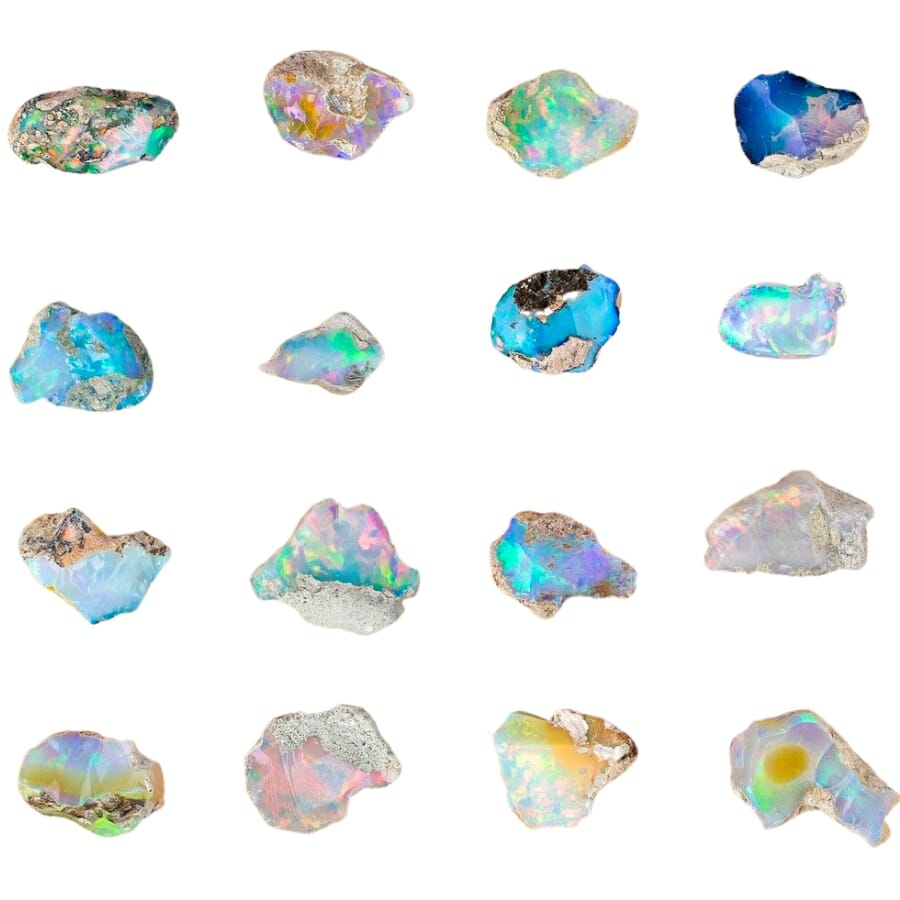
When rain falls on dry, parched ground, the rainwater, carrying tiny particles of silica, seeps into cracks in the ground. Over time, as it evaporates, the silica particles get left behind and settle in layers. Over millions of years, these layers turn solid and form what we know as opal.
What makes opal so special are its unique properties. Unlike other gemstones, which might be one solid color, opal has a play-of-color. This means it can display many colors at once, which seem to shift and change as you move the stone in light.
The colors you see are caused by tiny spheres of silica inside the opal. The size and arrangement of these spheres determine the colors we see.
The value of opal is influenced mainly by its rarity and use in jewelry. Because of its brilliant colors, it’s a favorite choice for rings, necklaces, earrings, and other adornments.
Also, certain types of opal, like the black opal or the fire opal, are rare. Anything rare in nature often carries a higher value.
Why you’re seeing more fake opal these days
Opals are known for their breathtaking play of colors. But because they’re so loved and can be expensive, some people try to make fake ones to sell and make money.
Also, because the demand for this gem has grown, there’s a rush to supply them to buyers. Some sellers might turn to fakes to keep up with the demand without spending much.
With new technologies and methods, making fake opals that look really close to the real deal has become easier. This means more fake ones are being sold to people who might think they’re buying a real one.
Remember, real opals can be rare and hard to find. If you want to know where to find opals, check out our article on that.
How To Identify Real Opal
It’s always a fun but challenging activity to identify your rock, especially if you think what you have is an opal. Because this gem has many imitators and fakers, it pays to know some neat tricks on how to identify a real opal
Below are some of the most simple and effective ones that you can do:
Look for color play
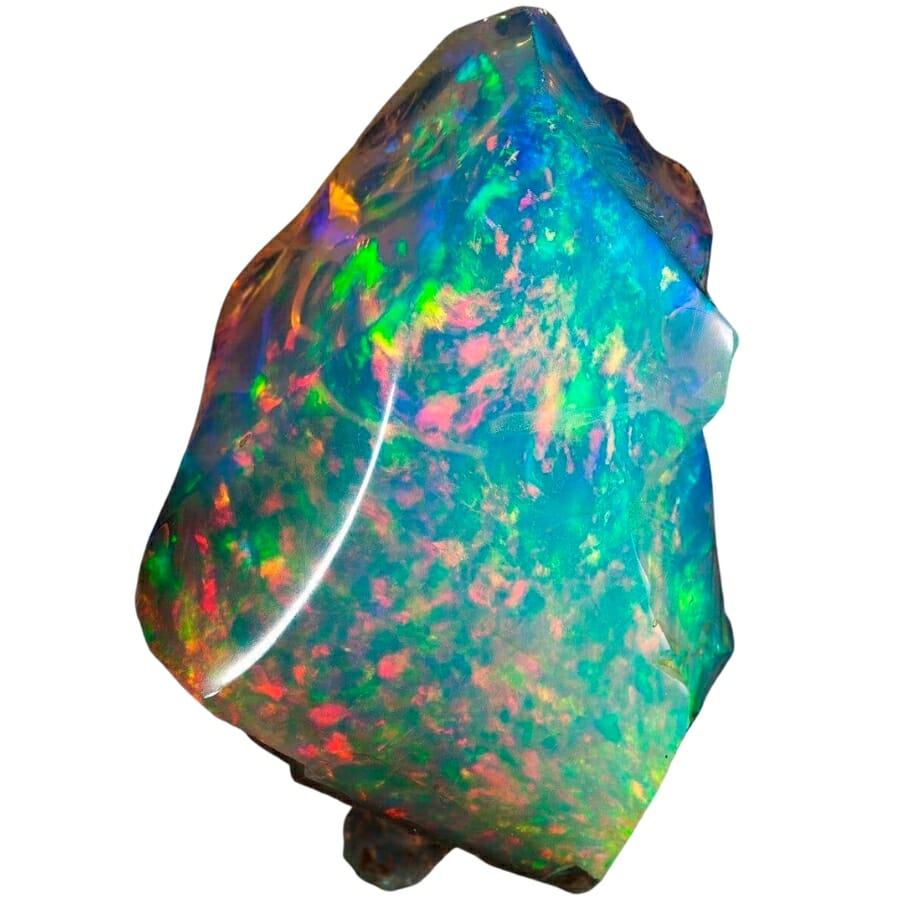
Color play is the magical dance of colors you see inside a real opal. When you move a natural opal under light, you’ll notice a mix of colors like red, blue, green, and yellow, all swirling and shifting around. It’s like a tiny rainbow captured in the gem!
This unique color show happens because of the way opals are made, with tiny bits of silica inside that bend light into various colors.
Fake opals might try to copy this look, but they usually don’t get it quite right. The colors in a fake might look dull, or they might not change and dance as much when you move the stone.
So, when you’re checking an opal, always look for that lively play of colors. If it’s there and looks natural, it’s a good sign that the opal is real!
Observe the body tone
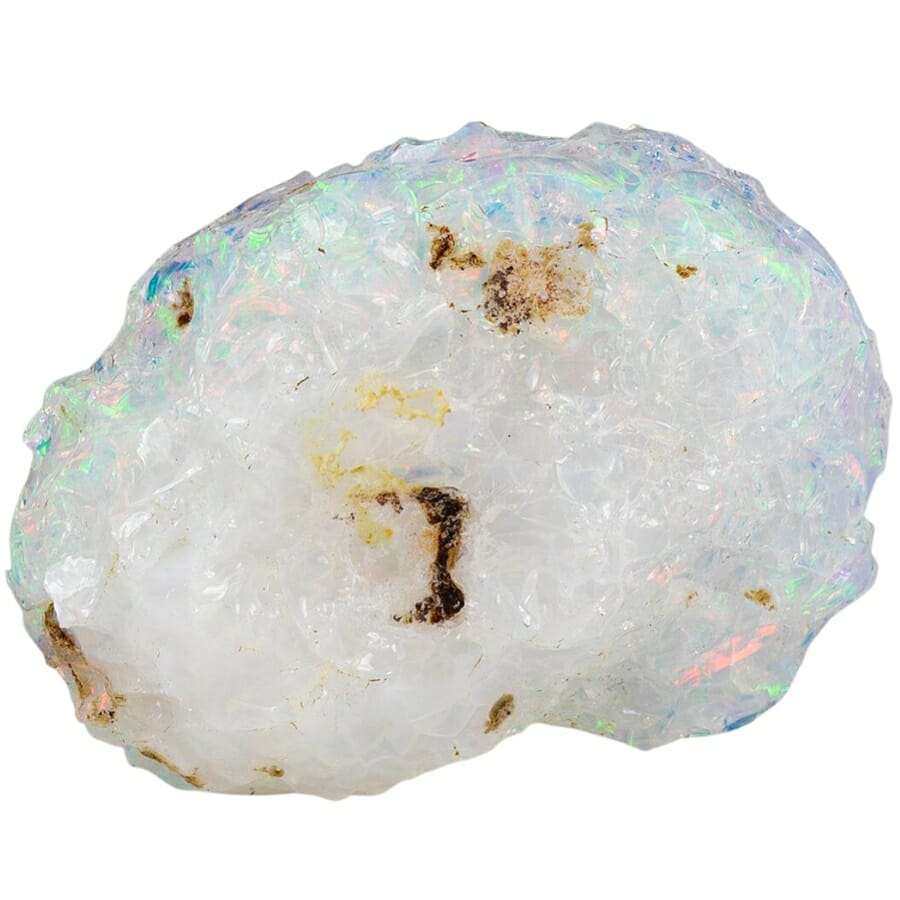
The body tone of an opal is like its background color. It can range from clear and see-through to a deep black.
Real opals have a certain depth and richness to their body tone. By holding it up to a light, you can see how it interacts with the light. Genuine opals should let some light pass through, even if they’re on the darker side.
Fake opals might not have this same kind of depth. They could look flat or too perfect. For example, a fake might be totally black without any light passing through or completely transparent like plain glass.
Checking the body tone is like looking at the canvas before admiring the painting. It sets the stage for the beautiful play of colors that genuine opals are famous for.
Check if there are surface bumps
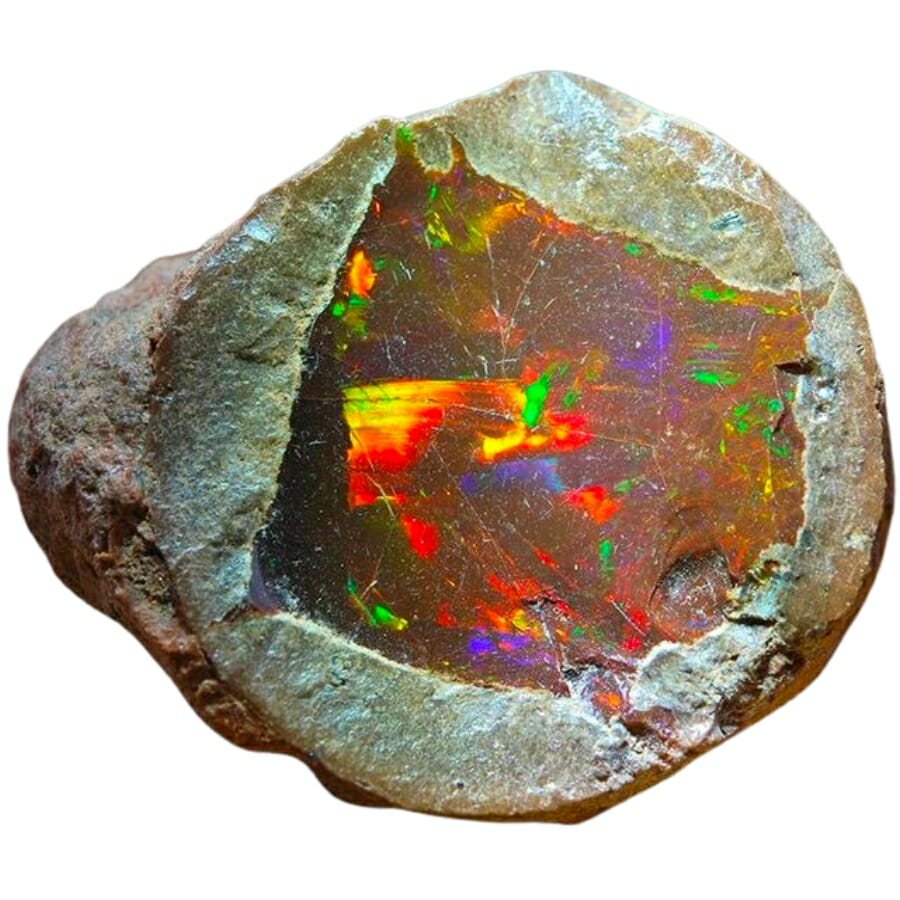
When you pick up an opal, one of the things you can check is its surface. Real opals are formed naturally over many years. Because of this, they often have tiny bumps, ridges, or even pits on their surface. It’s like the gem’s natural fingerprint.
Now, imagine a fake opal that’s made in a factory. These fakes are often produced to look perfect, so their surface is super smooth without any of those natural bumps or dents.
By gently running your finger over the opal, you can feel its texture. If it feels too smooth or like plastic, it might not be genuine. On the other hand, if you can feel some natural irregularities, it’s a good sign that the opal is real!
Examine the pattern
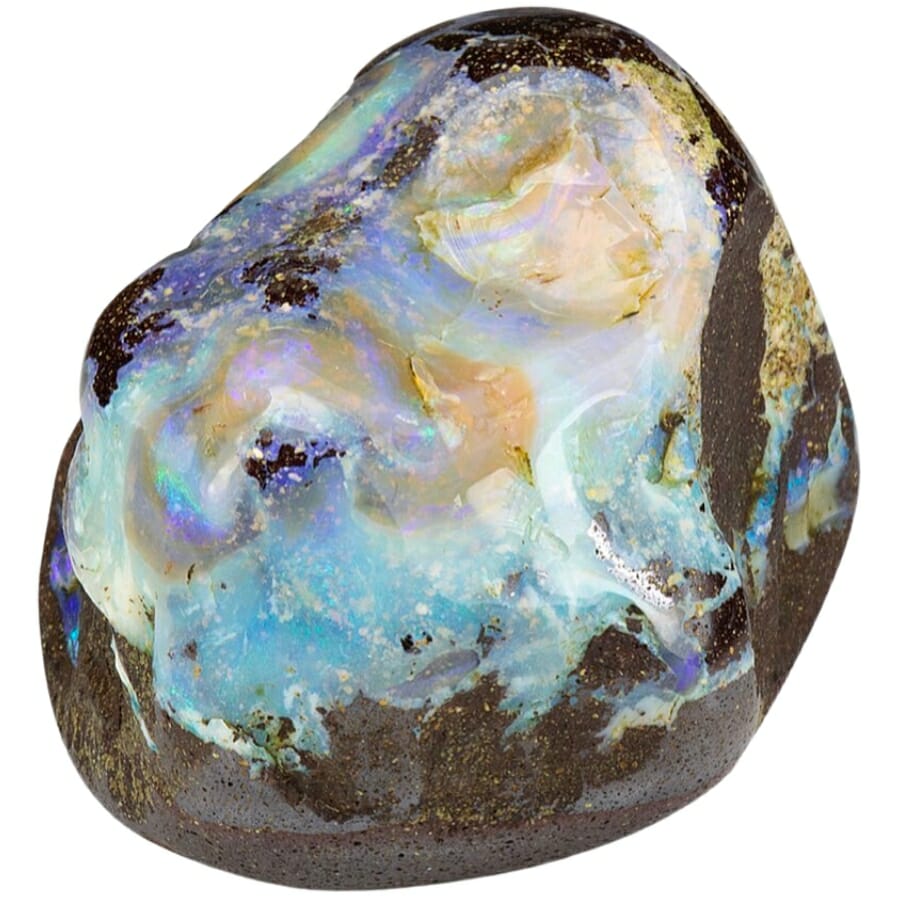
Opals have their own unique patterns of color dancing inside. Every real one has its own one-of-a-kind design.
These patterns are formed by tiny bits inside the opal that reflect light in special ways. The result? Swirls, patches, and specks of different colors!
When people try to make copies or fake opals, the patterns often look too perfect or repetitive, almost like a machine made them. It might seem like the same colors and shapes repeat over and over.
By examining the pattern closely, you can spot clues. If the design inside the opal looks too uniform or like it’s following a set pattern, be cautious. Real opals should have random, unpredictable patterns.
The Different Types Of Fake Opal And What They Look Like
Fake opal can look so much like a real one that you might be fooled into buying copies. Beware and get to know the usual stones, both natural and man-made, that are being sold and marketed as genuine opals.
Synthetic opal
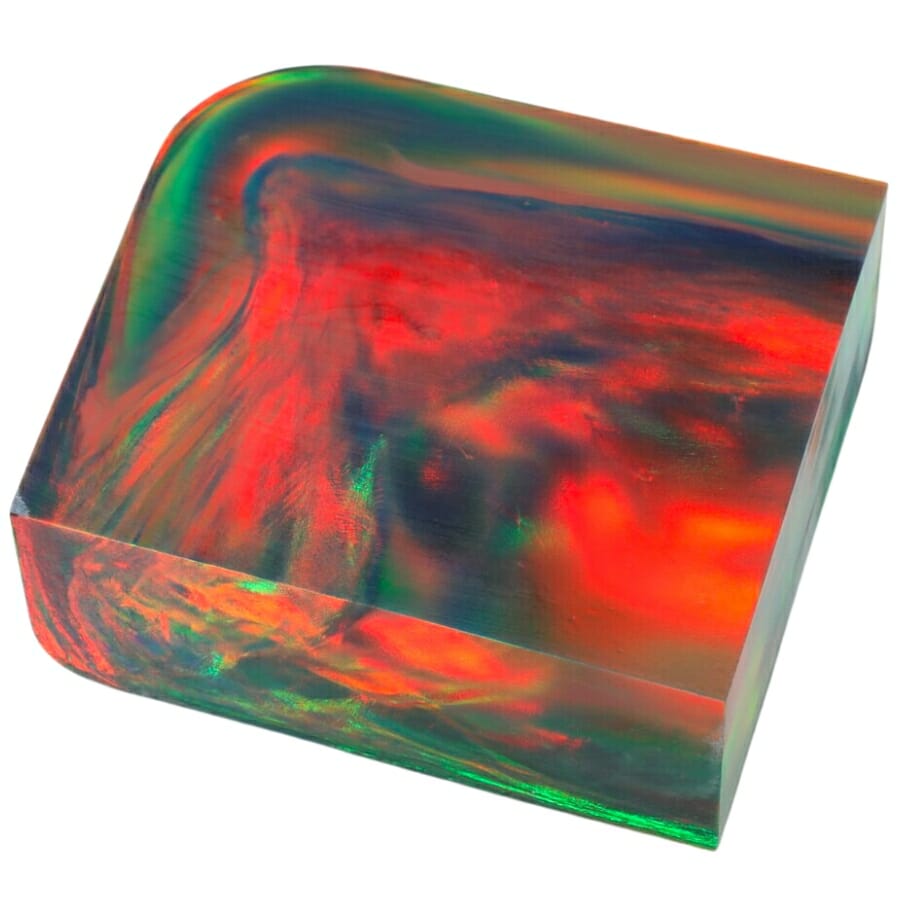
Synthetic opals are created by humans in labs. While natural opals take millions of years to form, synthetic ones are made in just a fraction of that time.
Here’s how the magic happens: Scientists start with silica that’s in gel form. They mix this with water and then place the mixture into molds. These molds give the synthetic opal its shape, like a round bead or a flat sheet.
Next, the molds are put into a big oven. The high heat helps the silica turn solid and form an opal-like structure. Over time, the water inside evaporates, leaving behind a solid, colorful stone that looks a lot like a natural opal.
But here’s the tricky part: these lab-made opals can look super real! They have bright, dancing colors just like natural opals. Because of this, some sellers might try to sell them as genuine opals, even if they’re not.
It’s not always a bad thing; synthetic opals are beautiful and usually cost less. But it’s important to know if you’re buying the real deal or a lab-made lookalike.
How you can identify synthetic opal being sold as real opal
Check if the color play is uniform
The colorful sparkles inside a real opal change when you move the stone around in the light. If the colors in your specimen seem the same no matter how you tilt or turn it, it might be synthetic. Real opals will show a variety of colors at different angles.
Try to see if it has layers
If you can, look at the side of the opal. Synthetic opals might have distinct layers when viewed from the side, especially if they are made as doublets or triplets (with layers of other materials). Genuine opals won’t have these clear layers.
Assess if the price is too good to be true
Real opals, especially high-quality ones, can be pricey. If you find an “opal” being sold at a very low price, be cautious. It might be a synthetic opal being passed off as genuine. Always ask the seller about its origin and if it’s natural or lab-made.
Moonstone
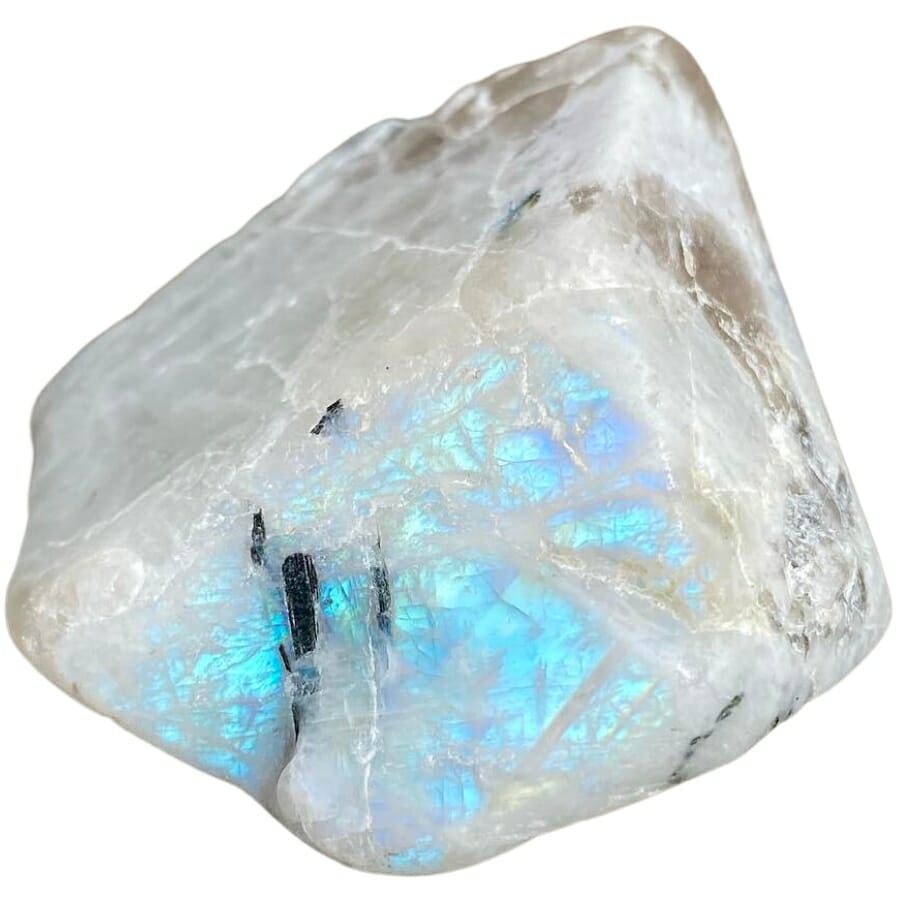
Moonstone is a type of mineral called feldspar. When molten rock cools and solidifies, it starts to form. As it cools, different layers of minerals stack up. These layers scatter light, giving moonstone its unique glow, known as “adularescence.”
Now, here’s where the confusion with opal comes in. Both opal and moonstone can have a playful shimmer that changes as you move the stone.
But while opal’s shimmer comes in many colors (like a rainbow), moonstone’s glow is usually blue or white. Because of this resemblance, sometimes people can mistake one for the other.
Some sellers, wanting to make more money, might even sell moonstone as opal, especially if the buyer isn’t very knowledgeable. Moonstone can be shaped into beads, rings, necklaces, and other jewelry, just like opal.
When buying, it’s essential to know the difference between moonstone and opal. Knowing the unique features of each stone will help ensure you’re getting the real deal, whether it’s a moonstone or an opal!
How you can identify moonstone being sold as real opal
Look at the glow
Moonstone has a unique shimmer, called adularescence, that’s like a soft blue or white glow that moves across the stone. Opal, on the other hand, displays a colorful play-of-color. If the stone’s shimmer is mainly blue or white, it might be a moonstone.
Check the transparency
Most moonstones are somewhat see-through or translucent. You might be able to see inside them a little, like looking through frosted glass. Opals can vary in transparency, but many popular opals (like white opals) are more opaque, meaning you can’t see through them.
Spot the rainbow
Opals are famous for showing off many colors in their play-of-color, like reds, greens, blues, and more. If the stone you’re looking at only has a soft, singular glow without a variety of colors, it’s more likely to be moonstone.
Labradorite
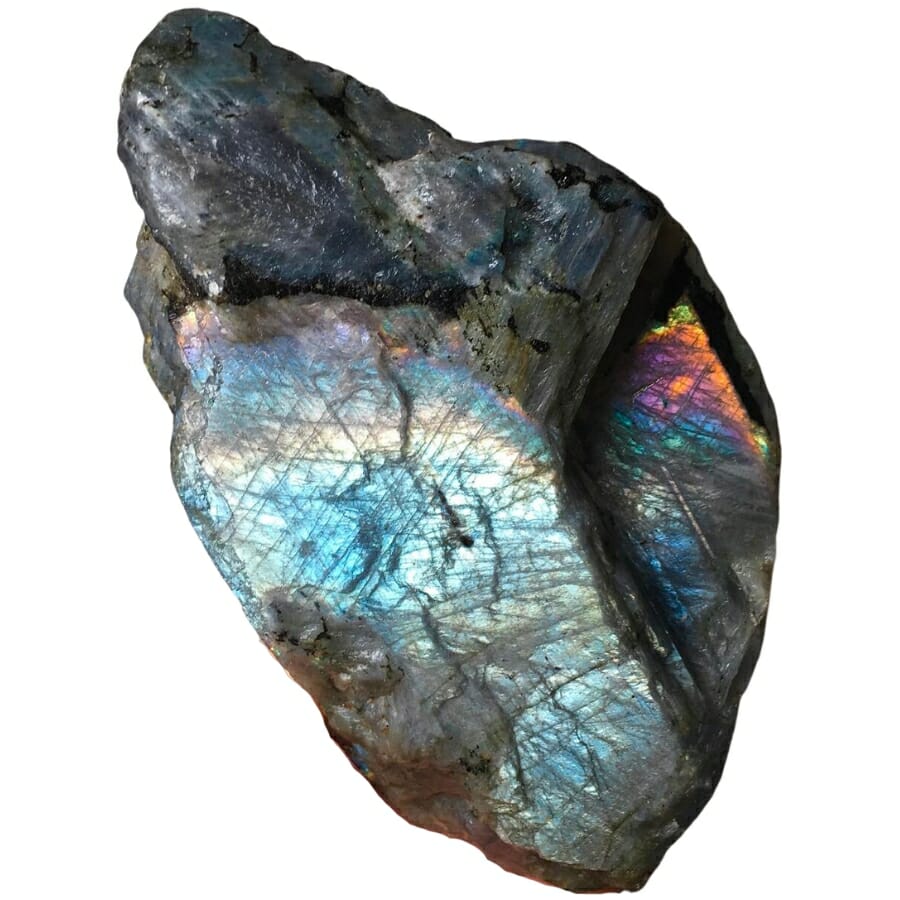
Labradorite, like moonstone, belongs to the feldspar mineral family. When hot molten rock deep under the Earth starts to cool down, labradorite begins to form. This cooling process happens slowly, allowing minerals to bond and create the unique structure of this gem.
What makes labradorite stand out is its flashy play of colors called labradorescence. When light hits the stone, it reflects and refracts, showing off dazzling colors like blues, greens, yellows, and sometimes even pinks or purples.
This colorful display can be similar to the play-of-color seen in opals, which is where confusion might arise.
Due to this resemblance, labradorites, especially high-quality ones with vibrant colors, might be presented as opal to buyers who aren’t gem experts. This gem can be polished and cut into various jewelry items, similar to opal.
How you can identify labradorite being sold as real opal
Check the base color
Labradorite typically has a dark gray or blackish base color. When you look at the stone without its shimmer, it often appears dark. Opals can come in a range of base colors, but many popular ones have lighter backgrounds like white or cream.
Observe the type of shimmer
The colorful display in labradorite, called labradorescence, tends to show as blues, greens, and sometimes yellows, oranges, or purples. Opal’s play-of-color can span a broader range of colors, including bright reds and pinks.
Look at the pattern of shine
Labradorite’s shine often looks like it’s coming from beneath the surface of the stone, almost like lights shining up from the bottom of a pool. Opal’s colors usually sit more on the surface and might spread out in patches, speckles, or ribbons.
Opalite
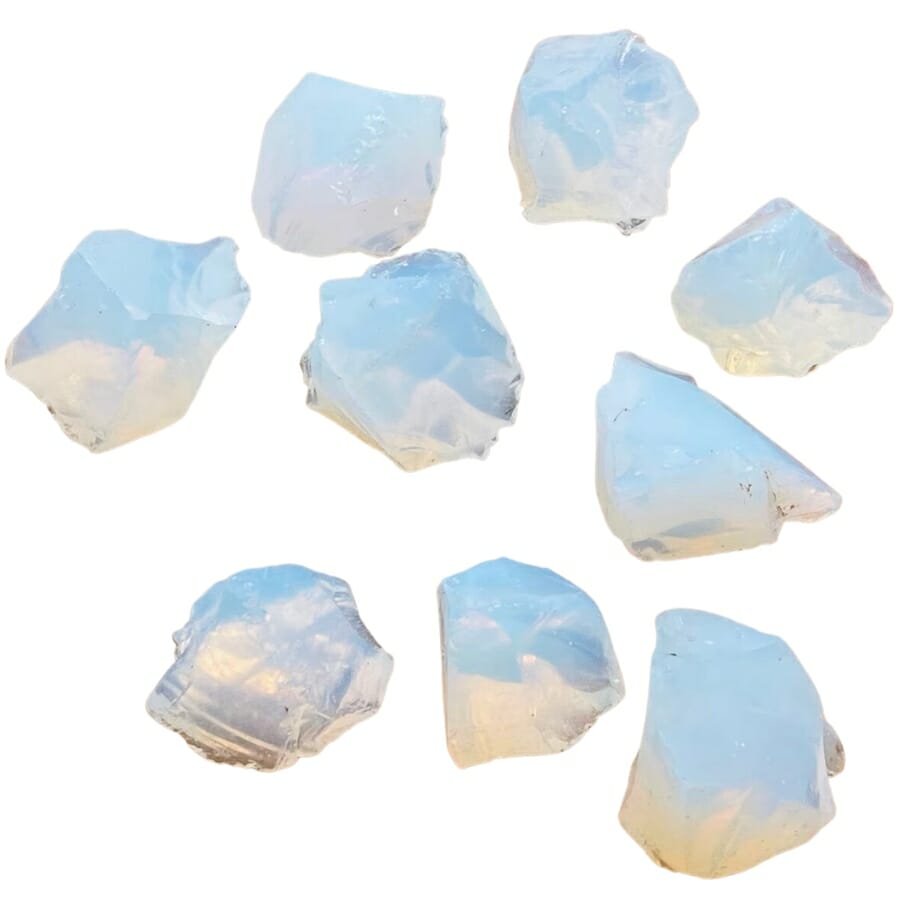
Opalite is a man-made glass that’s sometimes mistaken for opal, but the two are quite different. Opalite is crafted from a blend of chemicals that includes silicon dioxide, the main component of many types of natural glasses.
To get that shimmering, iridescent look we see in opalite, the glass is melted and then slowly cooled. This slow cooling helps to give it its unique, milky appearance.
The glow of opalite changes based on how light hits it. In certain lights, it might appear clear, and in others, it might look like a soft blue or even a golden orange. This play of colors can remind you of the play-of-color in opals, which is why some might think they’re looking at a genuine opal.
Here’s the tricky part: some sellers might label opalite as sea opal or moonstone opal to make it sound more mysterious or valuable. But remember, opalite is always man-made, while true opals are natural gemstones formed over millions of years.
If you’re on the hunt for genuine opal, it’s important to recognize and distinguish opal vs opalite so you know what you’re truly getting!
How you can identify opalite being sold as real opal
Look for consistency in color play
Opals’ play-of-color shows a spectrum of different colors as you move the stone under the light. Opalite, on the other hand, mainly shifts between a blue and orangey glow. If the color play seems too consistent and lacks diversity, you might be looking at opalite.
Check its transparency
Hold the stone up to a light source. Opalite is usually more translucent than genuine opals, and you can often see light passing through it easily. If it has a clear, milky appearance with a lot of light coming through, it’s likely opalite.
Do a simple hardness tap test
Opalite is made from glass, making it harder than a real opal. If you tap it gently (be careful!), opalite will produce a sound similar to tapping on glass, while a genuine opal will have a softer sound.
Howlite
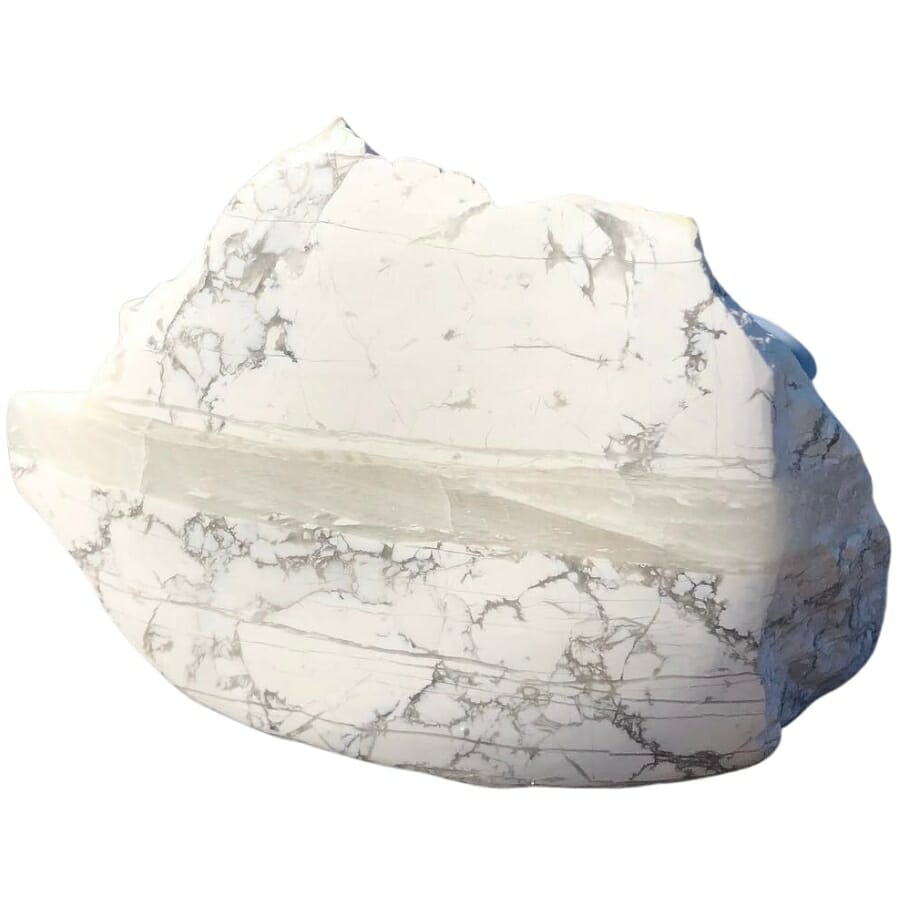
Howlite is an interesting stone, both in its natural form and how it’s sometimes used to mimic other gems, like opal. This white or colorless stone has grey or black veins running through it, which can make it look like a marble cake.
In nature, howlite forms when volcanic water moves through boron-rich rocks. The heat and chemical reactions create this unique stone. This process is slow and can take a long time, which is part of what makes genuine gemstones so special.
However, when it comes to selling gems, some people try to make more money by passing off less valuable stones as more expensive ones. This is where howlite comes into the picture.
Because of its natural white color and porous nature, it can easily be dyed to look like other gems. With the right treatments, howlite can be made to resemble turquoise, coral, and yes, even opal.
To make howlite look like opal, sellers dye it with bright colors that mimic the play-of-color seen in real opals. Once dyed, howlite can capture some of that shimmering opal appearance, especially if someone doesn’t know exactly what to look for.
How you can identify howlite being sold as real opal
Check the color patterns
Opals’ unique play-of-color shows many colors all at once, shimmering and shifting as you move the stone. Howlite, when dyed to imitate opal, often has solid, static colors. These colors won’t have the same dynamic, shifting appearance as a genuine opal.
Look for veining
Howlite naturally has grey or black veins running through it. Even if it’s dyed, sometimes these veins can still be visible. Opals don’t have these types of veins, so spotting them can be a giveaway.
Test how heavy it feels on your hand
Howlite is a porous stone, which means it can feel lighter than a solid opal of the same size. If you’ve held genuine opals before, you might notice that a howlite imposter feels slightly different in weight and texture.
How To Tell If Opal Is Real Vs Fake
Aside from the different natural and man-made stones that we shared above, there are others that people try to pass up as real and genuine opal.
If you’re worried about encountering a fake opal and not knowing it, here are a few more basic tips that you can use to spot these opal-wannabes.
How to identify fake opal when it’s cut or polished
Cut or polished opals can be mesmerizing with their play of colors, but it’s essential to ensure their authenticity before making a purchase. As the demand for these stunning gems rises, so does the influx of imitations in the market. Below are key pointers to help you discern genuine cut or polished opals:
Uniform play-of-color
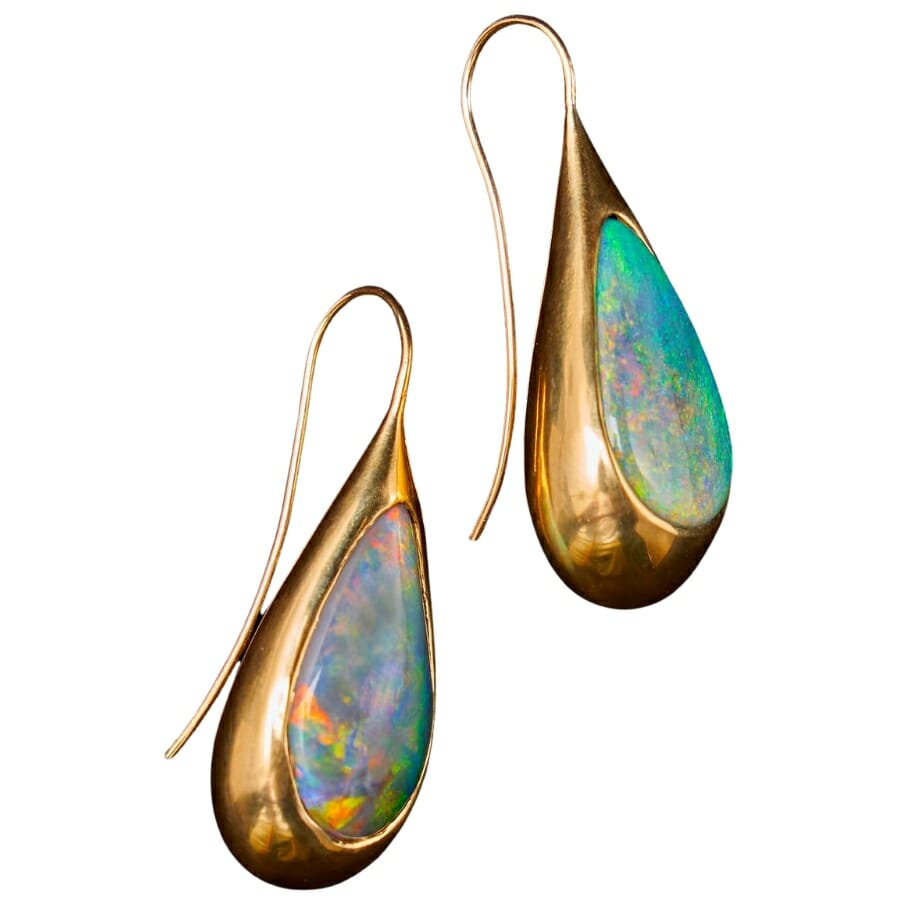
Opals’ play-of-color happens when light gets refracted or bent by the tiny silica spheres inside it. Depending on the size and arrangement of these spheres, you’ll see different colors flashing from the stone as you move it under a light.
No two genuine opals are the same because of this natural formation, which means the play-of-color in each stone will be unique.
When we talk about fake opals, one big giveaway can be a uniform play-of-color. Think of it like a pattern that looks too perfect or colors that shift in a very regular or repetitive way across the entire stone.
Mother Nature rarely does things in a perfect pattern, so when you see an opal where every part of it displays the same colors in the same order or intensity, it’s a hint that it might be fake.
Even color specs
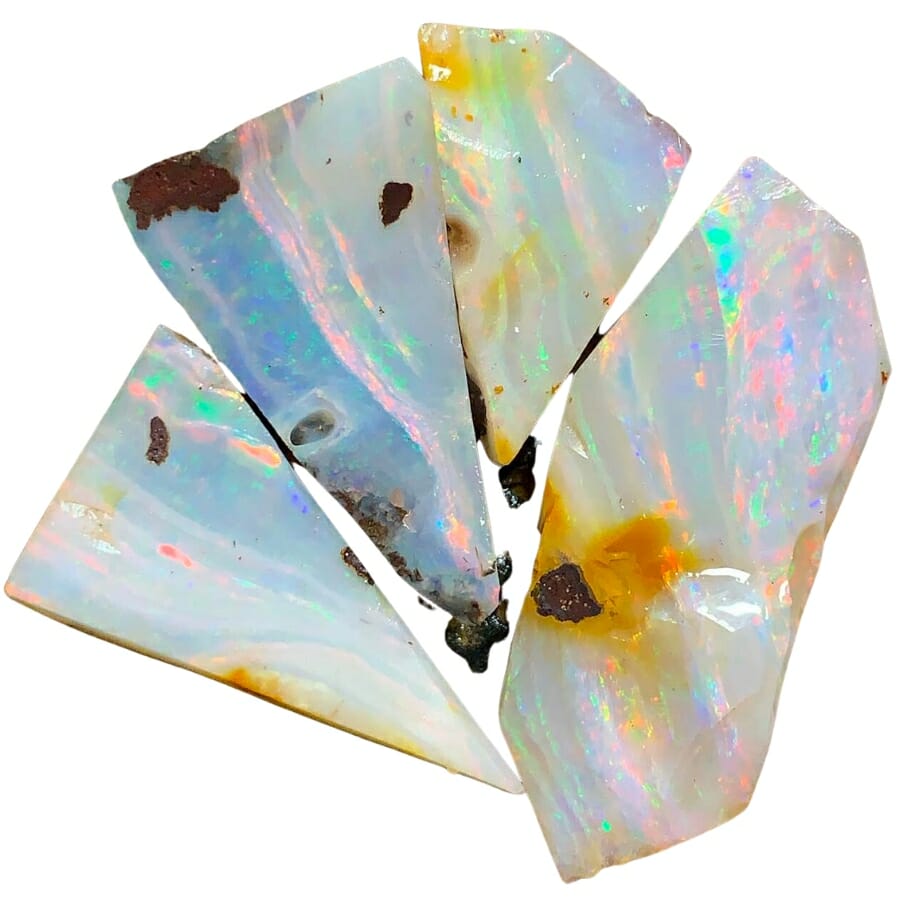
In a genuine opal, the color spots or specs will be all different sizes and scattered in a random way. Some areas might have a bunch of blue and green, while other parts might show red or yellow. This random pattern is a good sign that the opal is real.
But when you see fake or man-made opals, these color specs can sometimes be very even and the same size. They might be spread out in a way that looks too perfect or orderly.
This happens because the fake opal is made in a controlled environment where everything is designed to be just right. But nature is more random!
So, when you’re checking out an opal, pay attention to the little color specs inside. If they look too perfect or evenly spaced, you might be looking at a fake opal.
Presence of layers

When you look closely at a genuine opal, you’ll see a whole world of colors dancing and shifting, but one thing you typically won’t see is clear, defined layers.
Imagine making a sandwich. You can see the bread, the lettuce, the tomato, and the meat all stacked up. This is kind of how some fake opals look.
When fake opals are made, sometimes different materials are layered together. These layers can often be seen when the opal is cut and polished. So, if you look at a stone and can see clear layers it’s a hint that it might not be a genuine opal.
Don’t get this mixed up with the shifting colors of a real opal. Those colors move and flow, but they don’t create clear, separate layers. The layers in a fake opal might look like flat sheets or bands that don’t blend smoothly with the rest of the stone.
Here’s a handy tip: if you hold the opal up to a light, sometimes the layers in a fake opal will become more obvious. They may appear darker or lighter than the rest of the stone.
How to identify fake opal when it’s raw
Raw opals, untouched by tools or polish, have their own set of unique characteristics that set them apart from counterfeits. Let’s delve into the key signs to look out for when you’re examining unprocessed opal and hoping to spot any imposters.
Vibrant and consistent colors

In nature, opals rarely show consistent and super vibrant colors throughout the whole stone when they are uncut. It’s more common for natural opals to have areas with less color or patches that are dull.
Fake opals, on the other hand, might show colors that are too perfect. If you see an uncut stone that has really bright and consistent colors all over without any dull spots, you should be suspicious.
Manufacturers of fake opal can make them look super colorful to attract buyers. It’s a bit like seeing a rainbow with only bright colors and no soft hues.
Of course, there are real opals that might look very colorful too. But if you’re looking at a raw, uncut stone and it seems too good to be true, it might be a fake.
Smooth and even surface
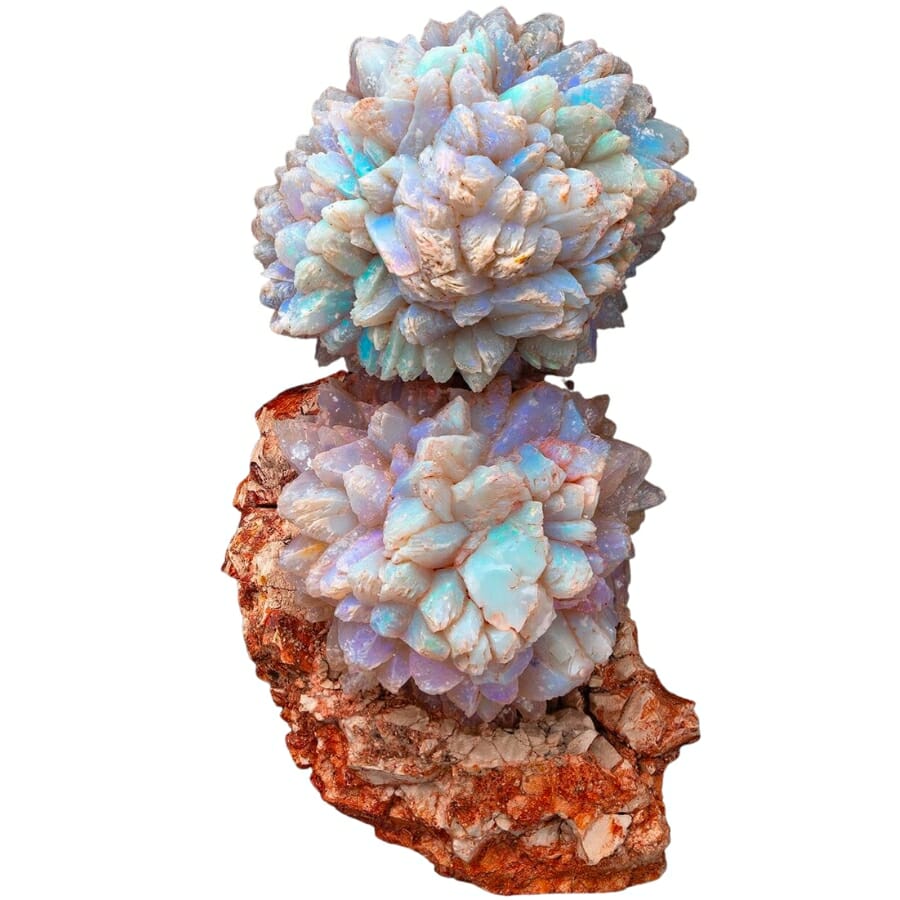
When opals come right out of the ground, they often have an uneven and rough surface. This is because they’ve been sitting for millions of years, getting shaped by natural processes.
But fake opals, which might be made in a factory or workshop, can look very different. If you see a raw, uncut opal with a surface that is super smooth and even all over, be cautious. This could be a sign that it’s not a real opal.
Real opals usually show signs of where they’ve been, with bumps, dips, and an irregular surface. A fake opal might be made from materials like plastic or resin, and these materials can be easily shaped to have a perfect surface.
Quickly adapting to your hand’s temperature
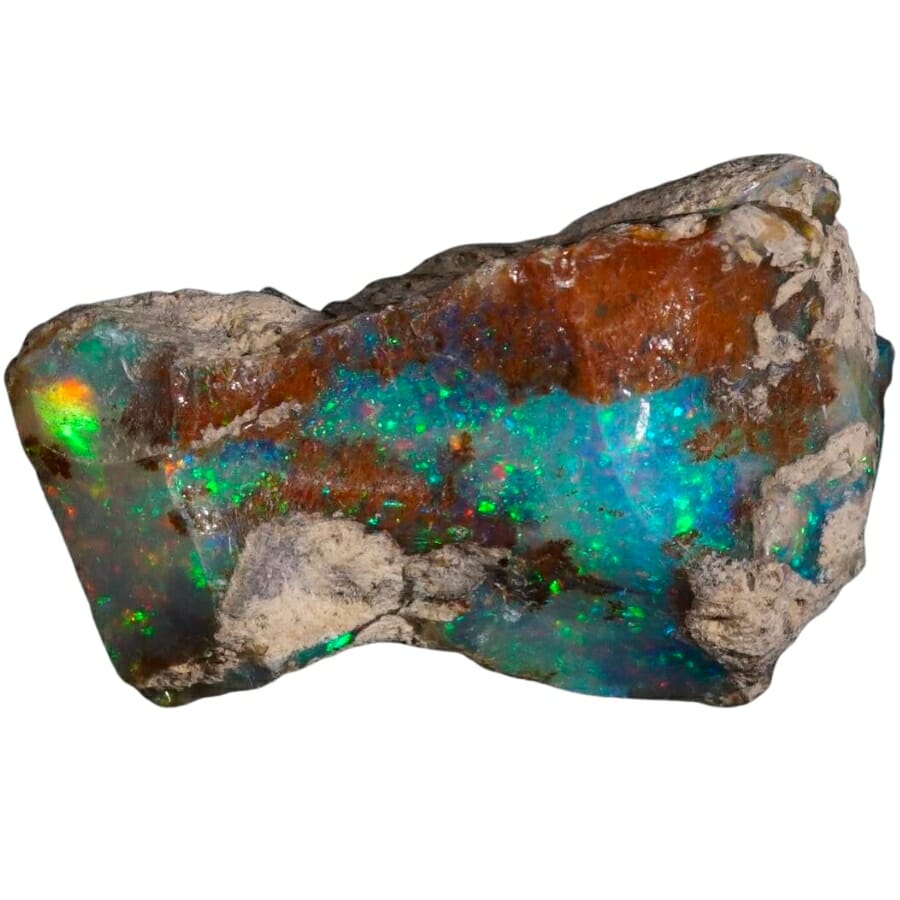
Opals have a unique ability to hold onto their temperature for a while. Think about a rock you pick up from the ground; it doesn’t instantly become warm when you touch it. Real opals behave in the same way.
When you pick up a real, raw opal, it might feel cool at first and will slowly warm up to match your hand’s temperature over time.
As for fake opals that might be made of materials like plastic or certain types of resin, one trait they share is that they can quickly change temperature.
So, if you pick up an opal and it almost immediately feels warm, matching your hand’s temperature, it could be a sign that it’s not a genuine opal.


